On show to the world: the Eucharistic Congress, 1932
Published in 20th Century Social Perspectives, 20th-century / Contemporary History, Features, Issue 6 (Nov/Dec 2007), Volume 15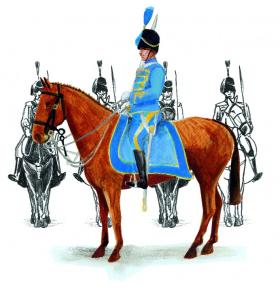
The Blue Hussars, established in 1931, made their first public appearance at the 1932 Eucharistic Congress. (John Conway)
The 31st International Eucharistic Congress, held in Dublin in 1932, is one of the most remarkable public events to have taken place in Ireland in the twentieth century. It generated a level of enthusiasm among Irish people that has few real parallels. With extremely favourable weather conditions prevailing in the run-up to and during the event, the country was in festive mood and the congress left an unforgettable impression on all who witnessed it. The sheer scale of the event bore striking testimony to the pride in identity, both national and religious, which patently guided the hundreds of thousands of people who participated.
Although the congress holds a distinct place in Irish history, such events, if not on quite such a large scale, had been taking place in various parts of the world since the late nineteenth century. Defined as gatherings of ecclesiastics and laymen ‘for the purpose of celebrating and glorifying the Holy Eucharist and of seeking the best means to spread its knowledge and love throughout the world’ (Catholic Encyclopaedia, 1910), international eucharistic congresses, held generally every two years in this period, were major demonstrations of global Catholicism that attracted considerable attention. The Dublin Congress took place over five days (22–26 June) in a city decorated and beautified to an exceptional degree. Visiting journalists and commentators, including the well-known Catholic intellectual G. K. Chesterton, were struck by the efforts of Dublin people, most especially the impoverished tenement-dwellers, to embellish their streets and laneways with bunting, festoons, banners, garlands, floral arrangements, grottos, shrines and various other forms of religious decoration.
1,500th anniversary of St Patrick’s mission
As Dublin was chosen as the venue for the congress, ostensibly at least, to celebrate the 1,500th anniversary of the beginning of St Patrick’s mission to Ireland, Early Christian Ireland was often a theme in the decoration. Versions of ecclesiastical artwork associated with that period featured prominently in the multifarious material published about the congress, for which there was a phenomenal demand. The great achievements of the early church fathers in Ireland’s ‘golden age’ were celebrated proudly. Replica round towers, for example, were erected in two city centre locations. With many distinguished prelates from around the globe visiting Dublin for the congress, along with the international media interest, there was a sense that Ireland was on show to the world.
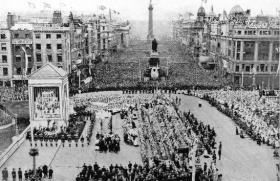
Mass is celebrated on O’Connell Bridge, Dublin
The congress also highlighted the remarkable number and status of Irish ecclesiastics serving both the Irish diaspora and countless others in many different parts of the world. Among those who participated in the congress was the Waterford-born archbishop of Sydney, Michael Kelly, who had sponsored a congress in his adopted city in 1928. Most Irish people would have been very aware of other Irish ecclesiastics (Daniel Mannix, Patrick Clune, James Duhig, etc.) who dominated the Catholic Church hierarchy in Australia at this time. Similarly, most of the dominant figures in the Catholic Church in the United States were either Irish-born or of immediate Irish descent. The archbishop of New York, Cardinal Patrick Hayes, was one of those who travelled over for the congress, as did the archbishop of Boston, William O’Connell, together with numerous other notable Irish-American prelates. A significant number of Irish missionary priests and bishops serving in Africa and elsewhere also participated. Among the many non-Irish prelates were the Catholic primate of Poland, Cardinal Hlond, the archbishop of Malines (Belgium), Cardinal Van Roey, and the archbishop of Paris, Cardinal Verdier. Although these very notable figures attracted much attention, it appears that the more exotic-looking churchmen, such as those of the Eastern Rite (as opposed to the Latin Rite), with their elaborate vestments, ‘strange’ liturgical practices and typically large beards, most captured the imagination and interest of a thoroughly engaged Dublin public.
The visual manifestations of enthusiasm for the congress were matched by the very notable levels of religious observance in advance of and during the event. Thousands participated in retreats and special services to pray for the congress. Diocesan and parochial units participating were organised throughout Ireland by a Eucharistic Congress League. A ‘Crusade of Prayer’ was organised for the success of the congress, involving thousands of people. A triduum was held in all the churches of the archdiocese of
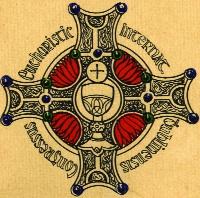
Dublin in the run-up to the congress. Amid spectacular lighting displays, and with the words Adoramus, Laudamus, Glorificamus beamed into the night sky in gigantic ‘letters of light’, midnight Mass was celebrated in all churches on the opening night, with many churches unable to accommodate all those who wished to attend. The greatest indicator of this religious fervour was the massive number of people who participated in the main congress events. The Men’s Mass, held in the ‘Fifteen Acres’ of the Phoenix Park on 23 June in front of a giant altar flanked by colonnades, was attended by a congregation of approximately 250,000 people. The Women’s Mass on 24 June was attended by some 200,000 women. The Children’s Mass on 25 June saw approximately 100,000 children gather in the Park. The main pontifical High Mass on 26 June was attended by an estimated one million people.
Count John McCormack sings Panis Angelicus at High Mass
The highlight of the congress was the High Mass in the Phoenix Park, which featured a live broadcast by Pope Pius XI from the Vatican. The broadcast was transmitted amidst considerable excitement via the most extensive PA system ever used anywhere in the world, with loudspeakers located in the Park, along the city quays and in various city centre locations. Dublin became a virtual open-air cathedral as the Mass was broadcast to many throughout the city who, it was noted, could be seen giving all the necessary responses. Following the Credo, John McCormack sang the offertory motet, Panis Angelicus, to a captivated audience. McCormack, a papal count since 1928, was an internationally renowned tenor whose greatly valued and emotionally significant participation confirmed the collective desire for a professional approach to the congress and added to the sense of pride that so many people derived from the event. It was an unforgettable moment for all present.
Following the motet, the consecration was heralded with a command in Irish to the attendant guard of officers to present arms, and, in a brilliantly orchestrated sequence, 36 glinting sword blades were pointed towards the altar. The total silence among the congregation was broken by six trumpeters who sounded a royal salute. This was followed by the tolling of an ancient bell traditionally associated with St Patrick (removed from the National Museum especially for the Mass). From the consecration to the communion the guard of honour continued with swords dramatically rendered (tiolalaigh claoite) in a highly impressive gesture of reverence. All sequences were performed exquisitely.
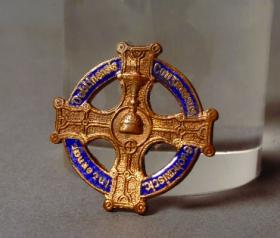
The entire Mass was organised with great precision and detail. Some 20,000 stewards (all voluntary) and 4,000 Catholic Boy Scouts, all with detailed instructions and duties, offered their services for the occasion, as they had throughout the congress period. All of the parishes of Dublin, all of the dioceses of Ireland and all of the overseas pilgrims were allocated special positions in the Park facing the altar. Large catering tents had been erected; information bureaux, first-aid stations, toilets and even a special water supply to the Park were established for the occasion.
After an interval of half an hour for refreshment, the Mass was followed by a procession of the Blessed Sacrament (a central part of every eucharistic congress), involving most of the enormous congregation, from the Park to the city centre. The logistical achievement here was truly extraordinary as the vast procession maintained perfect order moving down the city quays, with thousands dividing into carefully organised sections at Capel Street and Parliament Street (north and south sides of the River Liffey) to all eventually join together, in a remarkable scene, around O’Connell Bridge, where an altar had been especially erected for the service of benediction—traditionally marking the culmination of eucharistic congresses. On this occasion benediction of the Blessed Sacrament was given by the visiting papal legate, the major guest of the state, Cardinal Lorenzo Lauri, who had been a focal point for displays of devotion since his arrival in Ireland, amid memorable scenes of pomp and exuberance, on 20 June.
Special legislation
Although the congress itself took place over five days, ‘the Congress period’ was legally designated as commencing on 18 June and ending on 1 July. The Eucharistic Congress (Miscellaneous Provisions) Act, 1932 made provision for special traffic control regulations, special exemptions for hotels and restaurants in the Dublin area and numerous other arrangements. All efforts were made to confront the short-term accommodation crisis caused by massive numbers of people travelling to Dublin for the congress, most especially from other parts of Ireland. Large camps were established in Cabra and Artane. Emergency accommodation was provided in numerous national school, town hall and even library buildings in the greater Dublin area. Catering centres were set up in key city centre locations. Mattresses were produced on a very large scale in advance of the congress to enable countless Dublin households to accommodate visiting relatives and, where possible, other congress pilgrims. For many of those who travelled from abroad (particularly from America) the liners in which they travelled served as ‘floating hotels’. The numerous liners docked or moored in Alexandra Basin, Sir John Rogerson’s Quay and Scotman’s Bay excited the insatiable curiosity of Dublin people over the period and added to the sense of occasion, making a particularly beautiful sight when lit up on the warm summer nights.
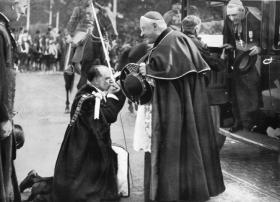
As befits any great congress, there was also an informative and intellectual side to the events. Public lectures, most particularly relating to the Eucharist and Ireland, took place, usually in front of packed audiences, in the Theatre Royal, the Savoy Theatre, the Mansion House and University College Dublin, then situated mainly in Earlsfort Terrace. UCD provided an ideal meeting place for the many sectional groups of congress pilgrims (groups from Portugal, Mexico, Uruguay, France, Malta, Poland, Holland, Belgium, Czechoslovakia, Spain, Italy, Lithuania, Australia, New Zealand, Canada, ‘the Oriental group’, etc.). These meetings included an address frequently focusing on Irish connections with the particular country—the work of Irish missionaries, etc. An exhibition in the college on Irish Catholic education, directed towards the visiting pilgrims, represented an emphatic demonstration of pride in Irish Catholic history. The old UCD building in St Stephen’s Green featured another very significant exhibition on Irish missionary work. Vast numbers of people visited this exhibition and, given that the number of men and women who dedicated themselves to missionary work would increase substantially over the next couple of decades, it seems reasonable to speculate that it may have been an inspiration to many.
Papal legate’s tour of Ireland
Shortly after the official congress events came to a close in Dublin the papal legate was made a Freeman of Dublin in a moving ceremony in the Mansion House. Cardinal Lauri’s cheerful countenance and pleasant manner had made a very positive impression. Some Irish clerics were already acquainted with him long before the congress. The archbishop of Dublin, Edward Byrne, was one of those who studied under Cardinal Lauri when he lectured at the esteemed De Propaganda Fide (Propagation of the Faith) College in Rome many years previously. Lauri was a very distinguished ecclesiastic who, having served for many years as papal nuncio to Peru and then Poland, was raised to cardinal in 1926 and became a special adviser to Pius XI before becoming the Holy Father’s ‘grand penitentiary’ in 1932.
During his final week in Ireland, the cardinal legate visited a number of Irish towns, where the welcome he received was just as jubilant as it had been in Dublin. On 28 June he visited the primate of all Ireland, Cardinal Joseph MacRory, at Armagh, where an address of welcome was presented to the legate on behalf of Armagh Urban Council. In villages as well as in towns along the route (overwhelmingly Catholic) throngs of people welcomed him. There were highly impressive scenes in Drogheda, Dundalk and
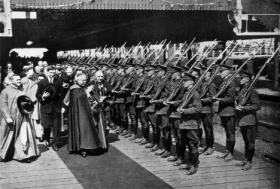
The papal legate, accompanied by de Valera, blesses the military guard of honour. Excommunicated from the church during the Civil War, the congress provided de Valera with the opportunity to demonstrate his Catholic bona fides. (Multitext Project)
Newry churches, where special welcomes were also given. On the following day the legate paid an informal visit to St Patrick’s College, Maynooth, where he was received by the president of the college and members of the staff. On 30 June the legate and his suite journeyed to Killarney by special train and enjoyed very enthusiastic receptions at Thurles, Mallow and Killarney. Following an address of welcome in Killarney, the legate was accompanied by the bishop of Kerry on a tour of some of the famous local beauty spots. As on so many other occasions, visiting journalists noted the beautiful decorations in the streets and local countryside.
On his departure from Ireland on 3 July, the legate wrote to the archbishop of Dublin:
‘I shall never forget the unforgettably glorious days of this Eucharistic Congress . . . all have participated, all have co-operated to make this congress a triumph, government and civic leaders, as well as ecclesiastical authorities, priests, members of religious communities, men, women and children, have all united to make this Eucharistic Congress a plebiscite of love for the Blessed Eucharist, a plebiscite of devotion to the vicar of Christ.’
Catholic triumphalism
The congress presents a very valuable snapshot of a period in modern Irish history when levels of religious devotion were at an apex. This was a time when it was extremely common for young men and women to join Catholic sodality or confraternity groups. Catholic imagery and icons were typically present in most households—statues of Our Lady of Lourdes, images of the Sacred Heart, pious medals, rosary beads, etc. These religious objects expressed a very strong cultural identity. There was also a tradition of devotion to local figures of piety such as Matt Talbot and St Charles of Mount Argus (only recently canonised). Organisations such as the Legion of Mary (founded in 1925) were increasing in strength; the Legion, in particular, benefited greatly from the congress as it provided an excellent opportunity to establish international contacts. With the expansion of various Catholic organisations in this period, the ultimate effect was an increase in the devotional command and power of the Catholic Church. The congress demonstrated that the Irish Free State was, to all intents and purposes, a Catholic state. There was a definite air of Catholic triumphalism about the congress, although the very deep-rooted historical circumstances, it was felt, provided ample justification for these celebrations. It should be stressed, however, that the general atmosphere during the congress must have further fostered a sense of exclusion or pronounced ‘separateness’ for at least some non-Catholics living in the state.
Fortuitous for the recently elected Fianna Fáil government
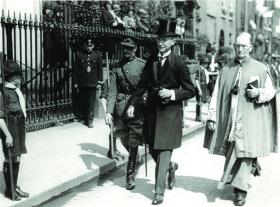
Governor-General James MacNeill about to enter the Pro-cathedral during the congress. There are no ministers accompanying him—yet another deliberate snub by de Valera’s government. (Cork Examiner)
On a political level, the congress proved fortuitous for the recently elected Fianna Fáil minority government, and in particular for the new president of the executive council, Éamon de Valera. Excommunicated from the church owing to his active support for the republican side during the Civil War in 1922, the congress provided de Valera with the opportunity to demonstrate his Catholic bona fides—very important given the overwhelmingly Catholic population of the state. Concerns about de Valera extended even to the Vatican at this time (owing, in particular, to an Irish envoy who repeatedly presented a very negative impression of him until his recent election victory). De Valera remained a devout Catholic throughout his life, however, and even during the Civil War he continued to enjoy the friendship of a number of churchmen. In 1932 he was on very friendly terms with the young president of Blackrock College, Dr John Charles McQuaid (future archbishop of Dublin), who hosted an enormous garden party to welcome the papal legate to Dublin. Photographs of de Valera at this event reveal him to have been in convivial form, comfortably exchanging greetings and pleasantries with the various prelates, many of whom he would already have met while on political tours of America and elsewhere. He made an impressive trilingual speech (speaking in Irish, Latin and then English) during the state reception for the papal legate in Dublin Castle on the following evening, and was very frequently photographed participating in the congress. De Valera maintained a very high profile throughout, and by the close of events there was no doubting his Catholic loyalties. This ultimately helped to consolidate his remarkable political appeal, with his distinct blend of traditional Gaelic Catholic nationalism attracting many voters. Calling a snap election six months after the congress, de Valera was able to form a majority government that would serve a full term. He remained in office (in both majority and minority governments) until 1948.
Governor-general snubbed
De Valera also used the occasion to deliver a serious snub to the representative of the British Crown in the Irish Free State, the governor-general, James MacNeill. De Valera had already declared his intention to terminate such links with the Crown that were written into the 1922 Free State Constitution. Shortly after assuming office in 1932 two of de Valera’s ministers (Frank Aiken and Seán T. O’Kelly), in a blatant affront, walked out of a function held by the French legation in Dublin when MacNeill and his wife arrived. Although MacNeill had been very prominent in the Catholic Emancipation centenary celebrations in 1929 (hosted by the previous Cumann na nGaedheal government), in the run-up to the congress in 1932 de Valera expressed dismay at MacNeill’s stated intention of having several ‘distinguished European Catholics’ as guests during the congress, with de Valera noting the embarrassment to the government. It was further stressed that the government would be unable to assist the governor-general in inviting any other visitors. During the garden party at Blackrock College special measures were taken by Dr McQuaid (at de Valera’s request) to minimise, wherever possible, contact between himself and MacNeill. Astonishingly, the governor-general was not invited to the lavish state reception in Dublin Castle to welcome the papal legate. Given such treatment it was hardly surprising that the situation came to a head later in the year and, following a rather sensational protest over his treatment, MacNeill was forced to resign. He was replaced by de Valera’s nominee, Domhnall ua Buachalla, who would fully comply with de Valera’s wish to dramatically lower the profile of the governor-general, until the office was abolished altogether by the Constitution Amendment Act in 1936.
Partition further entrenched
In terms of a broader significance, the congress highlighted a fundamental difference between the Irish Free State and Northern Ireland, where some Catholics travelling to the congress were attacked by loyalist mobs. The charge that such a vibrant Catholic celebration in Dublin, so thoroughly embraced at every level in the Free State, could only serve to further consolidate the partition of Ireland is undeniable. It should be stressed, however, that opposition to a united Ireland was a long-held bedrock political stance among Protestant unionists in Northern Ireland and, in a psychological and very real sense, partition was firmly entrenched at this stage. The congress did not offer any threat—only further confirmation, if any was needed, of existing beliefs. It has even been suggested that the unionist political élite quietly admired the congress. The pomp and ceremony involved in welcoming the papal legate in the south was akin to a royal visit elsewhere. No visit of any British monarch to Belfast had yet been carried off with such élan, and lessons could be learned from the planning and organisation of the congress. In truth, however, the only subsequent ‘royal’ visit to Ireland to compare in scale and popular enthusiasm was the visit in 1979 of a Polish ecclesiastic who had recently been elected head of the Holy Roman Apostolic See—Pope John Paul II.
Rory O’Dwyer lectures in history at University College Cork.
Further reading:
31st International Eucharistic Congress, Dublin 1932: a pictorial record (Dublin, 1932).
D. Keogh, Ireland and the Vatican (Cork, 1998).
J.P. McCarthy, 31st International Eucharistic Congress, Dublin 1932 (www.multitext.ucc.ie).
















